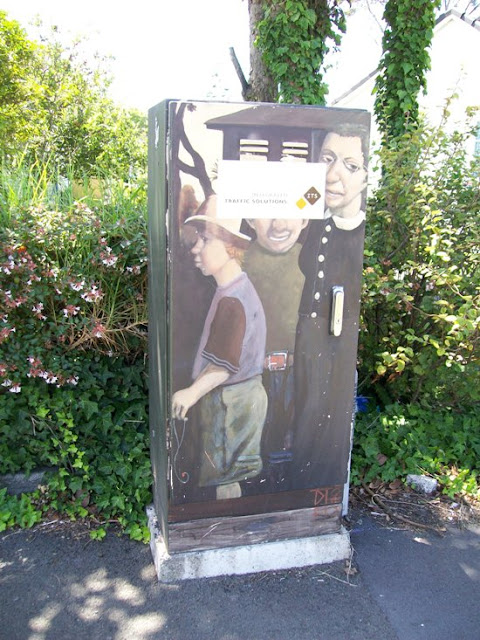Well, a bit of it. Yes, I have been to the Howick Historical Village (and intend to return again at some stage) but yesterday's journey out was to give a talk to the Howick branch of the NZ Society of Genealogists (one of a rash of talks I seem to have let myself in for over February and March, all over the place ...) And, this was the first time I'd been that far out east by myself, using good ol' public transport.
So -- above, the clock tower from the Highland Park shopping centre. It caught my eye, and I instantly thought that it reminded me of the traditional blockhouses during the Taranaki and Waikato land wars of the 19th century. I'll bet it's actually supposed to be something different, but -- I liked what I saw.
They like to have the occasional decorated rubbish bin out that way as well. And finials on their bus stop roofs! (I couldn't take a photo of the latter today, darn it, because there were a lot of people there waiting patiently for a bus ...)
Getting close to my destination ( I walked up from Highland Park shops to Ridge Road) ...
The very, very beautiful old St Andrews Presbyterian Church and cemetery, at the corner of Vincent and Ridge Roads.
This is a simply stunning country church (well, it was out in the country when first built in 1873). According to Alan La Roche, in his book The History of Howick and Pakuranga, Whitford, Bucklands and Eastern Beaches and Surrounding Districts (1991), this was designed by James Wrigley, and cost all of £175.
The new Presbyterian church at Howick was opened for Divine service on Sunday last, the 30th ult., at 3 p.m. The weather was propitious, and the assembled congregation filled all the available apace in the building. The Rev. John Macky was the officiating minister, and in the “service of praise" members of the choirs of the other congregations of his charge gave their assistance. After engaging in devotional exercises, including the leading of portions of Sacred Scriptures suitable for the occasion, the minister delivered a discourse founded on John iv., 21, 23, in which he unfolded the nature of Divine worship, as taught by our blessed Lord himself.
The collection, which was on behalf of the building fund, amounted to upwards of £6. The church is beautifully situated at the entrance of Howick, nearest to Panmure, and is a pretty and well-constructed building, creditable both to the architect, Mr. Wrigley, and to the builders, Mr. McInnes and Mr. White. It was a cause of regret that it had been forgotten to advertise the opening service in the Auckland journals, as it was hoped that some of the many kind friends in the city who had contributed to the erection of the church would be present on the occasion, and be gratified by seeing the result of their generous co-operation with their, in some respects, less favourably circumstanced country friends. In order as far as possible to make amends for this oversight, arrangements have been made for holding Divine service in the new church at 11 a.m. on Sunday next, when a further opportunity will be given of contributing to the building fund.
Southern Cross 3 April 1873

"The Rev McKay became blind in his old age but his faithful horse 'Jack' guided him safely to his preaching charge at Howick every Sunday from Otahuhu. He would spend Sunday afternoons preaching, and visited pensioners on Mondays before returning to Otahuhu. It is said children would guide the horse across a stream, the horse would know where to go."
Alan La Roche, p. 125
Today, the old church is known as the chapel, while behind it, built in 1981, is the new church, combining the congregations from St Andrew's and the (c.1907) Uxbridge Church. It serves the Howick Presbyterian Church, and the Auckland Taiwanese Presbyterian Church -- and is the meeting place for the Howick branch of the NZSG.
And then, once inside, I caught sight of this. This is a stained glass window, featuring the Presbyterian symbol of the burning bush, originally from the now vanished St Peter's Presbyterian Church in Grey Lynn. According to the information beside it, it was dedicated in honour of Gordon McCullough, a Grey Lynn parishioner who was a casualty during World War I. The window was later given by McCullough family members to Uxbridge Church during that church's extensions in 1956, but it was never used. Instead, it was found under the old church in 1981, while the new Howick Presbyterian Church was being constructed. Plans were adjusted to incorporate the window especially in the entry foyer of the new building.
This photo does not do the window justice. It is a truly stunning sight -- well done to the parishioners and administrators of the Howick church for restoring a piece of not only a piece of Presbyterian (and Auckland ) history to a place where it can be appreciated.

























































